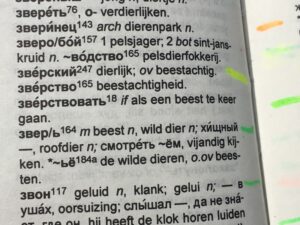

How to remember words – the seven steps
One thing is to collect new words, the other is: how to remember them.
To find new words is easy – they are there.
However, remembering them – that’s hard! How can we manage? This blog tells you the seven steps to take.
Estimated reading time 7 minutes
Author: Margreet Kwakernaak, author of Dutch for Dummies and 7 other textbooks on Dutch
Our starting point
To start with: we assume that you know how to find new Dutch words. Our blog Word learning: making it part of your daily life may be helpful. However, the blog you are reading now focuses on how to remember them.
Secondly, we assume that you are very motivated to learn the new language. Let’s say that you live in a country where the language is spoken. Living in that country gives you a lot of opportunities to come into contact with the language naturally.
Personal circumstances and word learning
Time, time, and once again time. You may be too busy for anything. Fortunately, part of language learning is informal: Dutch texts are everywhere in the street, you can watch Netflix with subtitling, and the internet provides Dutch 24/7.
However, when you have decided to learn Dutch, be happy as an adult. In the first place, you know how to study. Moreover, strong motivation will help you to persevere and take the 7 steps for each word you want to remember.
Finally, which are the 7 steps that are required?
Step 1 and Step 2: Look up the meaning and note the word, preferably writing each letter yourself
Step 1 – Translate. You’ll find a new word, and you want to know what the new word means. The Delft method, if you use that, makes it easy: you just click the word and get the translation in your language. Otherwise, you look it up, using your phone. And, when using Google Translate, do you add a star to the important words so that you can find them back easily? Finally, a conscience question. Do you ever reread your starred words?
Step 2 – Write. Bravo if you do so! However, it is much better, to write interesting words, the ones you want to remember first, somewhere. That might be step 2. You could write them in a word-learning app, such as Quizlet. Let’s dive deeper into step 2, but first I have a question. When you studied at university, did you make notes of lectures, or did you receive a handout later? And which lectures do you remember best: the ones that had interesting subjects, the ones you made notes of or the ones with handouts? Probably both options one and two. Copying and pasting are easy, but typing each letter yourself and exercising with the word later, is best.
Think the word over, listen to it and pronounce it.
In which order you take the steps, can vary. Most important is that they are all in the process.
Step 3 – Think over the word. However, that could be step 2 as well. Often, you take both steps at once. Writing down – or, copying and pasting it- gives you time to consider the word. Does the word look like another word, is it related to some word in another language you know? Or is it a different form of some other Dutch word?
Step 4 – Listen to the word. This may be step 1 as well. To memorize, some people need to see the written or printed word, others want to hear it. However, to store them in your memory, both actions are required.
Step 5 – Pronounce the word. A natural step after hearing it is to say the word aloud. You try the pronunciation, it’s like tasting the word. When trying out, tongue and brains are at work – that helps.
How to remember words, number 6
Decide whether you want to remember the word or not – and repeat it: Step 6
Beware! Some teachers consider making your own choices illegal. Others tell us that making up your vocabulary is quite natural. Anyway, a good language learning method made the selection for you: that method uses frequently used words only. And frequently used words are important words.
But, isn’t it quite a natural process that you remember the names of people who were important in your life and that you forget those who did not play a role in your emotions? Yes, it is, and thus, permit yourself not to do your best for words that are not useful for you now. Did you make the wrong decision on that? No problem, life will teach you and you will relearn the word later. Work on the words that you need, and repeat.
Turning theory into practice – the seventh step
Step 7 – Use the words in a real or a virtual conversation. The last step is the most difficult one. But not when you are studying with the Delft method with conversation classes, because step 7 is included in it. You turn theory – the text that you prepared for your conversation class – into practice in the conversation class. The Delft method has most of the mentioned steps. Besides, the Delft method is so intensive that during the course, you have no time for anything else than the conversation classes require. The 7 steps are available for later.
But, for others, how to find opportunities for practicing? How to make contact with Dutchmen is beyond the scope of this blog. One option is available for all of us: talking to an imaginary person. You can invent conversations with Dutchmen you meet at a party, with a Dutch friend, or with a Dutch colleague. Apple’s Siri understands Dutch, and Google’s Assistant does, but not for domestic utensils. Unfortunately, talking Dutch is not included in Microsofts Windows 11. It depends on your region, so you must find this out for yourself.
Can you ask for internet information in Dutch on your phone? It is fun!
Where do the 7 steps come from
Language learning specialists would not be specialists when they would not quarrel. However, their common advice is 4+1+1+1. The first 4 actions include hearing, reading, and semantisation, so getting to know the meaning of a word, writing it, or storing it, preferably embedded in a sentence.
Next comes consolidation: you repeat it in a spoken or written exercise or hear it and reread it – preferably in different sentences and situations.
The last step is to control the word. When you want to use the word, is it available, does it come up?
The best is to look your words over with some time in between – the whole word learning process may take several weeks, up to three months.
You can
Do you think: I will never manage?
Then it is good to realize that language learning is a long process, but you can make the word-learning process a part of your daily life. It is not a requirement to memorize 100 new words per week all your Dutch life. The hardest part is in the beginning.
Moreover, it is a natural phenomenon that you understand many more words than you can use. The era of learning long rows of separate terms by heart is over! Remember words in sentences that mean something to you – the rest will follow.
Haven’t you got that much patience, time, or discipline, consider taking part in Suitcase talen Delft method classes, the fastest way to learn to speak Dutch (NT2) By studying with e-learning and taking two well-guided conversation classes per week, you learn 100 new words per week!
Be warned that with the Delft method, it’s either run or die- if you don’t prepare your class with the e-learning (2 hours per class) you will not be able to take part in the conversation. Because of that, all students study hard – though after 5 weeks, which is the length of one Module, some of them need a break.
Conclusion
To remember a word, take 7 actions. They are:
- Translate
- Write
- Overthink
- Hear
- Pronounce
- Decide and repeat
- Use the words in a real or a virtual conversation
More on language learning
Read more about the Delft method Suitcase talen Courses
Don’t you know what your actual level of Dutch is? Use the Contact form, mentioning
- whether you did learn some Dutch and how
- your actual situation
- your target

